2024 lookahead: How could next year look for Indices, FX, commodities, and cryptocurrencies?
Table of Content
As 2023 draws to a close, traders will be anticipating a more upbeat year ahead, with inflation concerns abating to the benefit of market sentiment. Record highs across the Dow, DAX and CAC highlight that optimism, but this recent outperformance in equity markets does not necessarily means that the opportunities have passed traders by. While markets appear to be steadfast in their expectations of a swift reversal in monetary policy, traders will need to remain vigilant given the curveballs that such a highly volatile political an economic environment can serve to markets. Let’s take a look at some of the key factors that could shape the year ahead.
Inflation
Inflation has been the big cause for concerns over the past two years, with the rapid rise in price growth forcing central banks to another historic phase of monetary tightening. Fortunately, inflation appears to be on a favourable course, with US, UK, and eurozone inflation heading back towards target. While much has been made of the potential difficulty achieving that final leg down to 2%, there is a strong chance that we will instead start to see central banks concerned over the possibility often overshoot. In much the same way that central banks failed to act early enough to avoid much of the inflation seen over recent years, a decision to begin cutting interest rates once the 2% target has been reached will undoubtedly raise questions over whether we see headline inflation move well below that target. Should that occur, there will be a big focus on whether central banks appear willing to allow headline inflation to remain below their target for a period, with core prices possibly a new focus given their relatively elevated nature. The approach from central banks facing sub 2% inflation could be a key topic in 2024, especially if energy prices remain depressed.
The chart below highlights how the UK (1.66%) and eurozone (1.02%) are currently on track to exhibit below target inflation by May. By annualising the past seven months of inflation, we can see that the trajectory over that period would lead both regions back down below 2% once the April readings are stripped out. Interestingly this is not the case in the US, highlighting why markets were so confused at the relatively dovish approach from Jerome Powell compared with Christine Lagarde. This highlights a strong chance that we see a more advantageous position for the BoE and ECB when it comes to monetary easing. Perhaps markets are expecting too much from the Federal Reserve after all (six rate cuts expected from March).
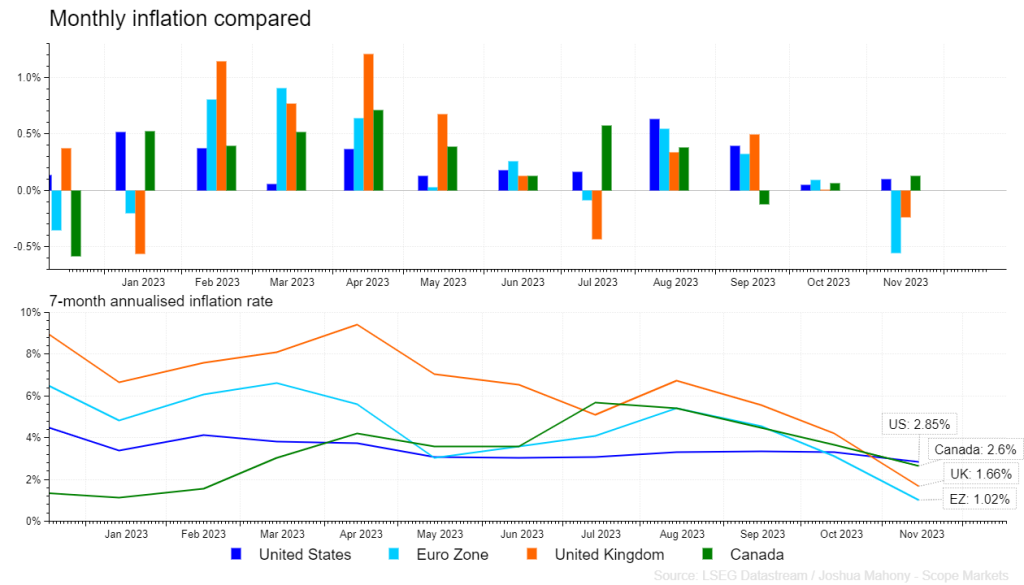
Economic concerns ahead?
What might cause a central bank to cut interest rates at a greater pace or ahead of a return to target inflation? Economic weakness would certainly help drive a more dovish outlook from the Federal Reserve, although the chance of a recession looks questionable as things stand. The chart below highlights how we often see recessions bring an end to an elevated interest rate environment. To some this is indicative of the negative impact higher rates will have a upon economy, signalling a possibility of an impending recession next year. Others will note the fact that processions typically occur when interest rates are being cut, although this is more than likely a reflection of the lagging effect of GDP data and willingness of central banks to move ahead of the curve. What sets this recent period apart from most historical periods of monetary easing is that we unlikely to see a strong phase of monetary easing in the face of strong economic data. Should we see a recession or hard landing take hold, markets would likely perceive this as a key driver of additional monetary easing, lifting equity markets once more.
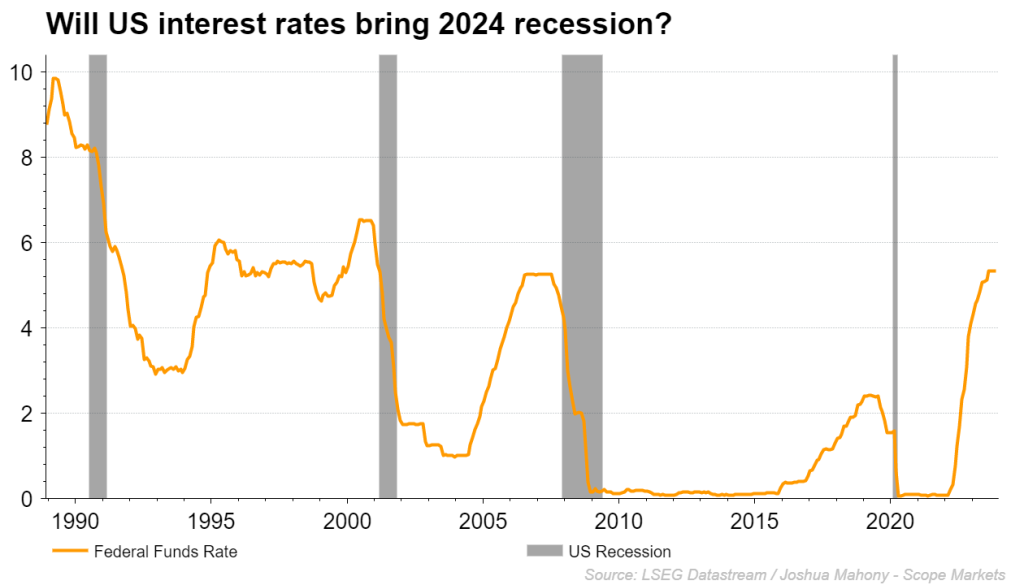
Political uncertainty
2024 promises to be a politically fuelled year, with a huge number of elections taking place over the breadth of the developed world. Chief amongst these will be the US presidential election, as Donald Trump bids to regain power once again. Quite how the cards will eventually fall across the board remains to be seen, but it should be noted that election years are typically beneficial for markets. Incumbent leaders or incentivized into pushing asset prices higher in a bid to remind voters that they are benefiting from the current status quo.
Meanwhile, pro-growth promises made during an election campaign can lead markets into a positive post-election mindset on the premise that we will see change for the better. The chart below highlights how just two of the past 9 U.S. presidential elections saw the S&P 500 trading lower just three months after the event. With markets clearly in an optimistic mood heading into 2024, there is a strong chance that this election year will end positively if history has anything to do with it.
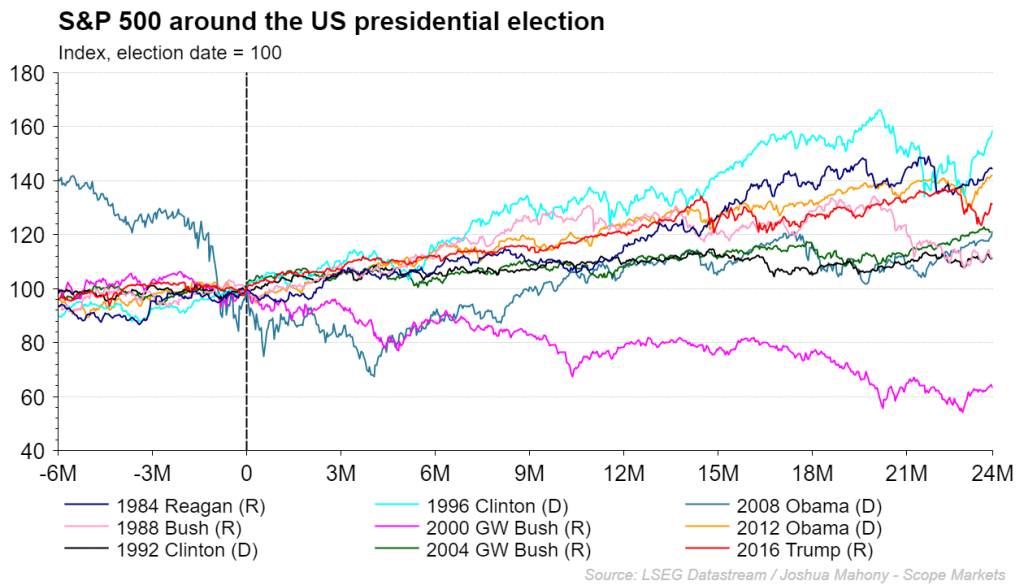
Indices
Equity markets enter 2024 on a high, with the Dow Jones industrial average following the DAX and CAC into fresh territory ahead of the new year. Much of this is associated with increased optimism that we will see central banks seek to boost economic growth through a loosening of monetary policy in the coming months. However, many will question whether these markets still have further to run given the already lofty levels seen as we enter this new year. On the chart below, we can see how the past five years have maintained a theme of US dominance, with indices in the US ranked according to their sensitivity to big tech. The FTSE 100 unfortunately remains a comparative laggard, with its inverse correlation to the pound meaning that it underperforms at times of market optimism.
The introduction of artificial intelligence as a new growth driver should maintain inflows as central banks loosen monetary policy and sentiment improves. With falling treasury yields pushing investors towards stocks, and declining cash levels, we are seeing funds continue to flow into US equities. However, keep a close eye on US inflation, with a strong possibility that the Fed have take a more cautious approach to easing given the relatively elevated inflation rate once we get to Q2. This may provide a period of outperformance elsewhere, but it is notable that US markets typically outperform over the long-term given their focus on growth over legacy businesses.
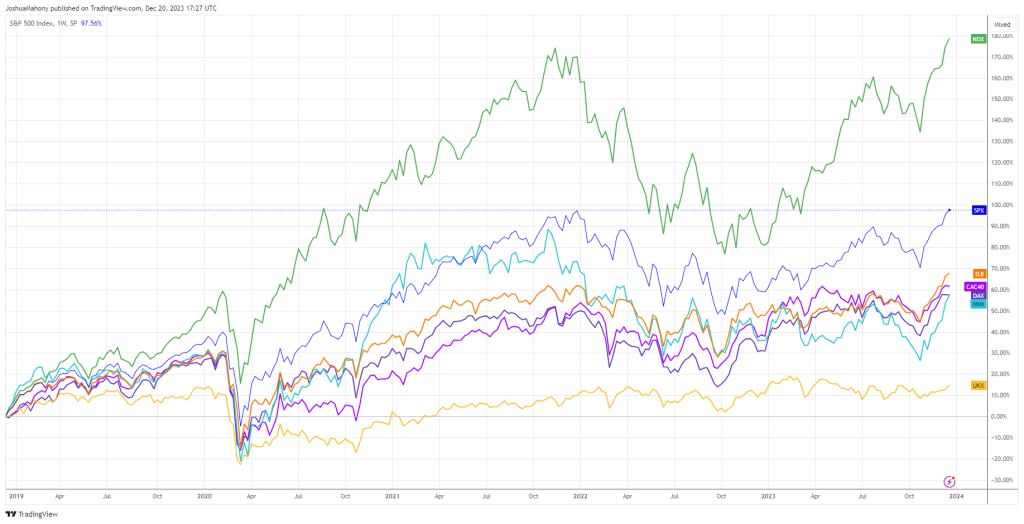
FX
The dollar looks at risk as markets move into a year that promises a fresh bout of expansionary central bank measures, with this haven typically doing best at times of economic concern. The relationship between the dollar and treasury yields has been positive over recent years, and thus the potential normalisation in treasuries does spell trouble for the dollar.
However, the strong possibility that the Federal Reserve will take a more cautious approach than markets currently expect does raise the possibility over a rebound in both the dollar and yields should Powell start to push back against the current rates outlook. Looking beyond that potential near-term disappointment, the prospect of lower inflation and rates should help boost risk assets, with the dollar looking at risk as a result.
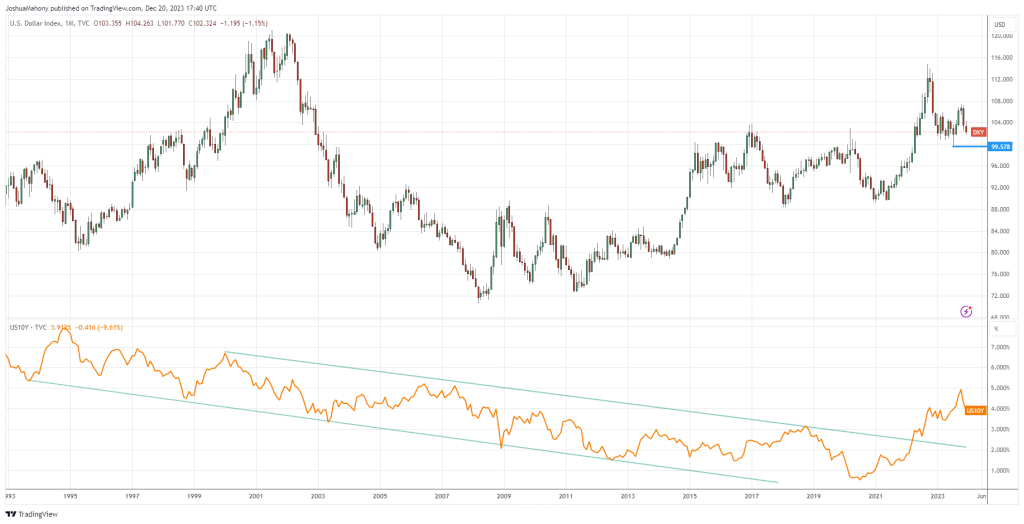
Precious metals
Precious metal holders are looking towards 2024 with optimism, as gold and silver seemingly bide their time ahead of a potential bullish breakout. From a historical perspective we have seen gold performed particularly well at times of monetary easing, which can bring confusion for those that believe it is responding to market weakness. As we have seen over recent years gold is a good haven asset when economic weakness is accompanied by monetary easing. However, this recent crisis brought higher interest rates alongside economic concerns, highlighting the lack of strength for precious metals. Nonetheless we have seen the lights of gold and silver seemingly in consolidation mode given the expectation that central banks will ultimately ease their way out of this crisis. With that in mind, a return to monetary easing next year should benefit gold and silver.
The chart below highlights the relationship between Federal Reserve monetary policy and precious metals since the year 2000. It is noticeable that the three periods of monetary easing kicked off periods of strength for gold and silver. While we saw some volatility within the period of easing itself, this generally marked the beginning of a new bullish phase across the sector. Notably the silver/gold ratio does fall over time, highlighting the general reliance of gold outside of these specific periods. However, the monetary policy fuelled periods of strength for precious metals does typically see a rise in the silver/gold ratio, highlighting the strong likeliness that any upside breakout in the space will also come with silver outperformance.
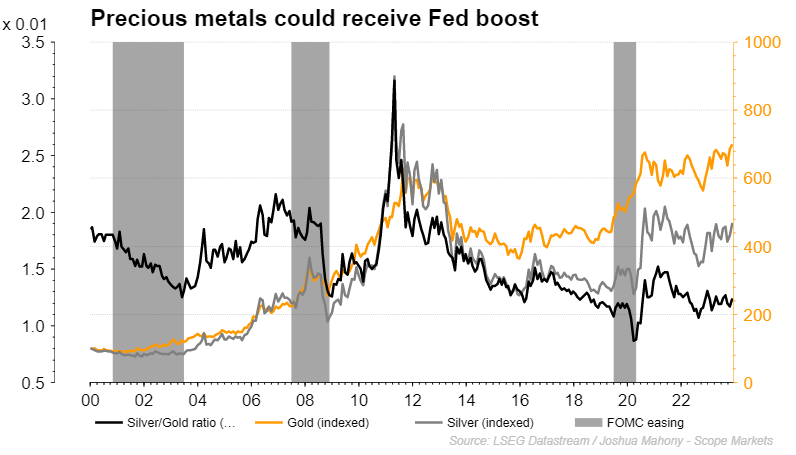
Crypto
The Crypto space looks particularly interesting this year, with the bitcoin halving event coming at a time when risk-on sentiment brings greater interest for this more speculative market. Bitcoin trades in a highly cyclical manner, centering around the having events that occurs each four years. As seen below this typically sets off a period of massive outperformance in Bitcoin that lasts roughly a year. With the 2024 having event expected around April, the run up seen over recent months appears to be a case of traders positioning themselves for a potentially historic year ahead. Watch out for potential volatility, with this market likely to remain sensitive to wider risk attitudes in the markets. Nonetheless with Wall Street expected to bring huge inflows of capital in the likely event that the Bitcoin ETFs are approved, the cryptocurrency sphere looks set to grab the headlines once again in 2024.
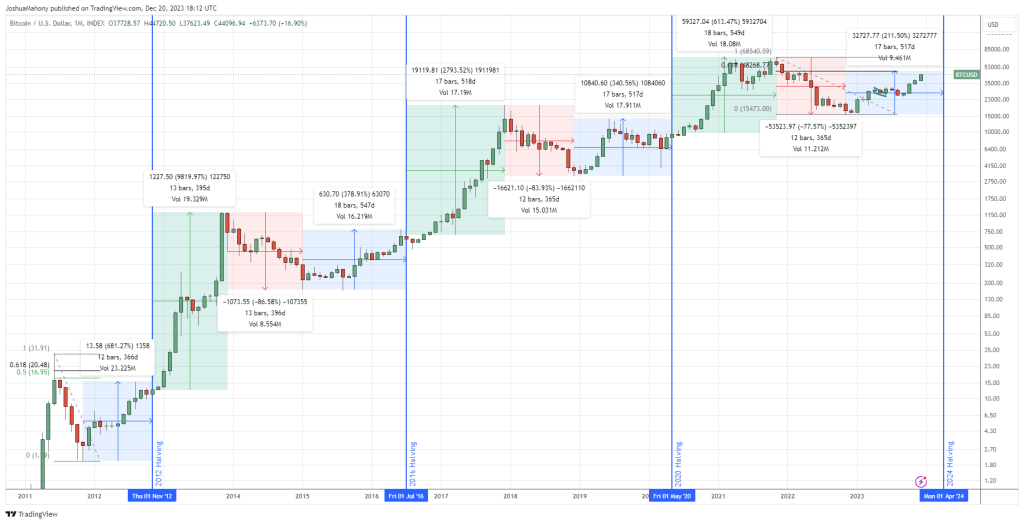
Disclaimer: This material is a marketing communication and shall not in any case be construed as an investment advice, investment recommendation or presentation of an investment strategy. The marketing communication is prepared without taking into consideration the individual investors personal circumstances, investment experience or current financial situation. Any information contained therein in regardsto past performance or future forecasts does not constitute a reliable indicator of future performance, as circumstances may change over time. Scope Markets shall not accept any responsibility for any losses of investors due to the use and the content of the abovementioned information. Please note that forex trading and trading in other leveraged products involves a significant level of risk and is not suitable for all investors.







